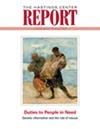安乐死在加拿大的医学治疗。
IF 2.3
3区 哲学
Q1 ETHICS
引用次数: 0
摘要
这篇评论认为,安大略省验尸官办公室的MAiD死亡审查委员会最近的报告证实了加拿大的安乐死制度是如何将生命的结束作为一种治疗形式正常化的,通常只针对间接与健康有关的痛苦。提交人是委员会的一名成员,他通过一些案例说明,似乎优先考虑的是如何获得死亡,而不是防止过早死亡,往往是由在相关临终保健方面受过有限培训的保健专业人员进行了非常基本的能力和知情同意程序之后。本文章由计算机程序翻译,如有差异,请以英文原文为准。
Euthanasia as Medical Therapy in Canada
This commentary argues that recent reports of an Ontario coroner's office's MAiD Death Review Committee confirm how Canada's euthanasia regime has normalized ending of life as a form of therapy, often for only indirectly health-related suffering. The author, a member of the committee, illustrates with some of the cases how access to death rather than protection against premature death appears to be prioritized, often after very basic capacity and informed consent procedures by health professionals with limited training in relevant end-of-life health care.
求助全文
通过发布文献求助,成功后即可免费获取论文全文。
去求助
来源期刊

Hastings Center Report
医学-卫生保健
CiteScore
3.50
自引率
3.00%
发文量
99
审稿时长
6-12 weeks
期刊介绍:
The Hastings Center Report explores ethical, legal, and social issues in medicine, health care, public health, and the life sciences. Six issues per year offer articles, essays, case studies of bioethical problems, columns on law and policy, caregivers’ stories, peer-reviewed scholarly articles, and book reviews. Authors come from an assortment of professions and academic disciplines and express a range of perspectives and political opinions. The Report’s readership includes physicians, nurses, scholars, administrators, social workers, health lawyers, and others.
 求助内容:
求助内容: 应助结果提醒方式:
应助结果提醒方式:


